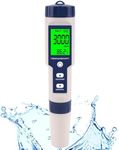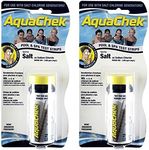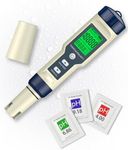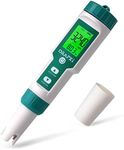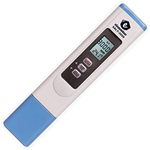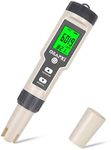Buying Guide for the Best Pool Salt Meters
Choosing the right pool salt meter is important for keeping your pool water safe and comfortable. A salt meter helps you measure the amount of salt in your pool, which is crucial for pools that use saltwater chlorination systems. The right meter will make it easy to check your salt levels, helping you avoid problems like equipment damage or uncomfortable swimming conditions. When picking a pool salt meter, focus on the features that match your pool size, your maintenance habits, and how much detail you want in your readings.Measurement RangeThe measurement range tells you the lowest and highest salt levels the meter can detect, usually shown in parts per million (ppm). This is important because your pool's salt system works best within a certain salt range. Some meters are designed for low salt levels, while others can handle higher concentrations. If you have a standard residential pool, look for a meter that covers the typical range for saltwater pools, which is usually between 2,500 and 6,000 ppm. If you have a larger or commercial pool, or if you use your meter for other water sources, you might need a wider range. Always check your pool system's recommended salt level and make sure the meter can measure it accurately.
AccuracyAccuracy refers to how close the meter's reading is to the actual salt level in your pool. This is important because inaccurate readings can lead to adding too much or too little salt, which can damage your pool equipment or make swimming uncomfortable. Meters usually list their accuracy as a plus-or-minus value (for example, ±2%). Higher accuracy is better, especially if you want precise control over your pool chemistry. If you just want a general idea of your salt level, a meter with moderate accuracy may be enough. If you want to keep your pool perfectly balanced, look for a meter with high accuracy.
Ease of UseEase of use describes how simple it is to operate the meter and read the results. Some meters are digital and show the salt level on a screen, while others use color changes or manual scales. If you prefer quick and clear readings, a digital meter is usually easier. If you don't mind a little extra work, manual meters can be just as effective. Think about how often you'll use the meter and whether you want something straightforward or don't mind a few extra steps.
Calibration MethodCalibration is the process of setting the meter to ensure it gives accurate readings. Some meters are auto-calibrating, while others require you to use a calibration solution. Auto-calibrating meters are more convenient and require less maintenance, making them a good choice if you want a hassle-free experience. If you don't mind doing a little extra work and want to save on cost, a manual calibration meter can be a good fit. Consider how comfortable you are with calibration and how often you're willing to do it.
Durability and Water ResistanceDurability and water resistance refer to how well the meter can handle being used around water and in outdoor conditions. Since you'll be using the meter near your pool, it's important that it can withstand splashes and occasional drops. Some meters are fully waterproof, while others are only water-resistant. If you plan to use the meter frequently or in wet conditions, look for a model with good water resistance and a sturdy build. If you'll only use it occasionally and can be careful, a less rugged meter may be fine.
Display TypeThe display type is how the meter shows you the salt level. Digital displays are easy to read and often show more precise numbers, while analog or color-based displays may require a bit more interpretation. If you want quick, clear results, a digital display is usually best. If you don't mind reading a scale or matching colors, an analog or color-based meter can work well. Think about your preference for reading results and choose a display type that matches your comfort level.

